Montreal University
The Université de Montréal is a public research university in Montreal, Quebec, Canada.
The francophone institution comprises thirteen faculties, more than sixty departments and two affiliated schools: the École Polytechnique (School of Engineering) and HEC Montréal (School of Business). It offers more than 650 undergraduate programmes and graduate programmes, including 71 doctoral programmes.
The university has Quebec's largest sponsored research income and the fourth largest in Canada, allocating close to $447.2 million to research conducted in more than 150 research centres as of 2007. It is also part of the U15 universities. More than 55,000 students are enrolled in undergraduate and graduate programs, making it the second largest university in Canada in terms of student enrolment.
History
Early years
As an institution, the university was first founded when the Université Laval in Quebec City founded a new branch in Montréal in 1878, which became known as the Université de Laval à Montréal. This initially went against the wishes of Montréal's prelate, who advocated an independent university in his city. Certain parts of the institution's educational facilities, such as those of the Séminaire de Québec, had already been established in Montréal as early as 1876. The Vatican granted the university some administrative autonomy in 1889, thus allowing it to choose its own professors and license its own diplomas. However, it was not until May 8, 1919 that a papal charter from Pope Benedict XV granted full autonomy to the university. It thus became an independent Catholic university and adopted Université de Montréal as its name. Laval composed by Wilfrid Beaudry was dedicated to the students at Laval University and the Université de Montréal. The music for piano was published in Québec by J. Beaudry, circa 1906.At the time of its creation, less than a hundred students were admitted to the university's three faculties, which at that time were located in Old Montreal. These were the faculty of theology (located at the Grand séminaire de Montréal), the faculty of law (hosted by the Society of Saint-Sulpice) and the faculty of medicine (at the Château Ramezay).Graduate training based on German-inspired American models of specialized course work and completion of a research thesis was introduced and adopted. Most of Québec's secondary education establishments employed classic course methods of varying quality. This forced the university to open a preparatory school in 1887 to harmonize the education level of its students. Named the "Faculty of Arts", this school would remain in use until 1972 and was the predecessor of Québec's current CEGEP system.
Founding by provincial charter
Although a branch of Laval University was planned as Montreal's first French-language university, it was not until February 14, 1920, that the first provincial charter founding the university was passed.The second provincial charter was passed in 1950. The policy of university education initiated in the 1960s (following the Quiet Revolution) was a response to popular pressure and the belief that higher education was a key to social justice and economic productivity for individuals as well as society. The third provincial charter, which was passed in 1967, defined the Université de Montréal as a public institution, dedicated to higher learning and research, in the administration of which students and teachers would have the right to participate.
Campus relocation

Former campus on Rue Saint-Denis in 1903.
From 1876 to 1895, most university classes took place in the Grand séminaire de Montréal. From 1895 to 1942, it was housed in a building at the intersection of Saint-Denis and Sainte-Catherine streets in Montreal's eastern downtown Quartier Latin.
Unlike English language universities in Montréal, such as McGill University, the university suffered a lack of funding for two major reasons: the relative poverty of the French Canadian population and the complications ensuing from its remote management from Quebec City. The downtown campus was hit by three different fires between 1919 and 1921, further complicating the university's already precarious finances and forcing it to spend much of its resources on repairing its own infrastructure.
By 1930, enough funds had been accumulated to start the construction of a new campus on the north west slope of Mount Royal, adopting new plans designed by Ernest Cormier. However, the financial crisis of the 1930s virtually suspended all ongoing construction. Many speculated that the university would have to sell off its unfinished building projects in order to ensure its own survival. Not before 1939 did the provincial government directly intervene by injecting public funds. Campus construction subsequently resumed and the mountain campus was officially inaugurated on June 3, 1943. The Cote-des-Neiges site includes property expropriated from a residential development along Decelles Avenue, known as Northmount Heights.
The university's former downtown facilities would later serve Montreal's second francophone university, the Université du Québec à Montréal (UQAM).
Nuclear research
In 1943, the university assisted the Western Allies by providing laboratory accommodations on its campus. Scientists there worked to develop a nuclear reactor, notably by conducting various heavy water experiments. The research was part of the larger Manhattan Project, which aimed to develop the first atomic bomb. Scientists here managed to produce the first atomic battery to work outside of the United States. One of the participating Québécois scientists, Pierre Demers, also discovered a series of radioactive elements issued from Neptunium.
Growth and expansion
Two distinct schools eventually became affiliated to the university. The first was the École Polytechnique, a school of engineering, which was founded in 1873 and became affiliated in 1887. The second was the École des Hautes Études Commerciales, or HEC, which was founded in 1907 and became part of the university in 1915. The first francophone school of architecture in Canada opened in 1907 at the École Polytechnique.
Between 1920 and 1925, seven new faculties were added to the initial three: Philosophy, Literature, Sciences, Veterinary medicine, Dental surgery, Pharmacy and Social sciences. Notably, the Faculty of Social sciences was founded in 1920 by Édouard Montpetit, the first laic to lead a faculty. He thereafter fulfilled the role of secretary-general until 1950.
In 1965, the appointment of the university's first secular rector, Roger Gaudry, paved the way for modernization. The university established the first adult education degree program offered by a French Canadian university in 1968. An important event that marked the university's history was the École Polytechnique massacre. On December 6, 1989, a gunman armed with an automatic rifle entered the École Polytechnique building, killing 14 people, all of whom were women, before taking his own life.
Since 2002, the university has embarked on its largest construction projects since the late 1960s, with five new modern buildings planned for advanced research in pharmacology, engineering, aerospace, cancer studies and biotechnology.
Campus

Map of the university's Mont-Royal campus.
The university's main campus is located on the northern slope of Mont-Royal in the Outremont and Côte-des-Neiges boroughs. Its landmark Pavilion Roger-Gaudry, designed by noted architect Ernest Cormier, and named for former rector Roger Gaudry, can be seen from around the campus and is known for its imposing tower. It is built mainly in the Art Deco style, with some elements of International style.
The campus is served by the Côte-des-Neiges, Université-de-Montreal, and Édouard-Montpetit stations.metroApart from its main Mont-Royal campus, the university also maintains four regional facilities in Lanaudière, Laval, Longueuil, Québec and Mauricie. The campus in Laval, just north of Montréal, was opened in 2006. It is Laval's first university campus, and is located in the area near the Montmorency metro station. In October 2009, the university announced an expansion to its Laval satellite campus with the commissioning of its six-storey Cité du Savoir complex. In order to solve the problem of lack of space on its main campus, the university is also planning to open a new campus in Outremont.
The Centre hospitalier de l'Université de Montréal (CHUM) and the Centre hospitalier universitaire Sainte-Justine are the two teaching hospital networks of the Université de Montréal's Faculty of Medicine, although the latter is also affiliated with other medical institutions such as the Institut universitaire de gériatrie de Montréal, Montreal Heart Institute, Hôpital Sacré-Coeur and Hôpital Maisonneuve-Rosemont.
Academics
Université de Montréal is a publicly funded research university, and a member of the Association of Universities and Colleges of Canada. Undergraduate students make the majority of the university community, accounting for 74 percent of the university student body, followed by mater students at 19 percent, and doctoral students at 7 percent. The full-time undergraduate programs comprise the majority of the school's enrolment, made up of 42,684 undergraduate students. From the 1 June 2010 to the 31 May 2011, the university conferred 7,012 bachelor degrees, 461 doctoral degrees, and 3,893 master degrees.
Depending on a student's citizenship, they may be eligible for financial assistance from the Student Financial Assistance program, administered by the provincial Ministry of Education, Recreation and Sports, and/or the Canada Student Loans and Grants through the federal and provincial governments. The university's Office of Financial Aid acts as intermediaries between the students and the Quebec government for all matters relating to financial assistance programs. The financial aid provided may come in the form of loans, grants, bursaries, scholarships fellowships and work programs.
Faculties and departments
Faculty of Arts and Science
- Canadian Centre for German and European Studies
- Centre for Spanish Resources
- Centre for Classical Studies
- Centre for East Asian Studies (CETASE)
- Centre for Ethnic Studies of Montreal Universities
- Centre for Medieval Studies
- Department of Anthropology
- Department of Biochemistry
- Department of Chemistry
- Department of Communications
- Department of Demography
- Department of English Studies
- Department of French-Language Literatures
- Department of Geography
- Department of History
- Department of Art History and Film Studies
- Department of Computer Science and Operational Research
- Department of Linguistics and Translation
- Department of Comparative Literature
- Department of Literature and Modern Languages
- Department of Mathematics and Statistics
- Department of Philosophy
- Department of Physics
- Department of Psychology
- Department of Political Science
- Department of Biological Sciences
- Department of Economics
- Department of Sociology
- Information Technology Education Centre (DESI)
- Language and Foreign Cultures Education Centre
- School of Library and Information Sciences
- School of Criminology
- School of Psychoeducation
- School of Industrial Relations
- School of Social Work
- Orientation and Studies Management Service (SAGE)
Faculty of Continuing Education
Faculty of Dentistry
- Department of Reconstructive Dentistry
- Dentistry Department of Oral Health
- Department of Stomatology
Faculty of Education
- Continuing Education
- Centre for Teacher Training
- Department of Didactics
- Department of Administration and Educational Foundations
- Department of Psychopedagogy and Andragogy
Faculty of Environmental Design
- Institute of Urban Planning
- School of Architecture
- School of Landscape Architecture
- School of Industrial Design
- Interior Design Program
Faculty of Graduate Studies
Faculty of Law
Faculty of Medicine
- Department of Anesthesiology
- Department of Biochemistry
- Department of Environmental and Occupational Health
- Department of Family Medicine
- Department of Health Administration
- Department of Medicine
- Department of Microbiology and Immunology
- Department of Nutrition
- Department of Obstetrics and Gynecology
- Department of Ophtalmology
- Department of Pathology and Cellular Biology
- Department of Pediatrics
- Department of Pharmacology
- Department of Physiology
- Department of Psychiatry
- Department of Radiology, Radio-Oncology and Nuclear Medicine
- Department of Social and Preventive Medicine
- Department of Surgery
- School of Rehabilitation
- School of Speech Therapy and Audiology
Faculty of Music
Faculty of Nursing
Faculty of Pharmacy
Faculty of Theology and Religious Sciences
Faculty of Veterinary Medicine
- Department of Veterinary Biomedicine
- Department of Clinical Sciences
- Department of Pathology and Microbiology
Department of Kinesiology
School of Optometry
Reputation
| University rankings | |
|---|---|
| ARWU World | 102-150 |
| ARWU Social Sciences | 75-100 |
| THE-WUR World | 104 |
| THE-WUR Health Sciences | 47 |
| Canadian rankings | |
| ARWU National | 5-6 |
| Maclean's Medical/Doctoral | 12 |
| THE-WUR National | 6 |
Université de Montréal has consistently been ranked one of Canada's top universities. The 2011-2012 Times Higher Education World University Rankings placed the university 104th in the world, and sixth in Canada. The 2011 QS World University Rankings ranked the university 137th in the world, and fifth in Canada.
The 2011 Academic Ranking of World Universities (ARWU) rankings, the university ranked 102-150th in the world. In terms of national rankings, Maclean's ranked the university 12th in their 2011 Medical Doctoral university rankings. The university was ranked in spite of having opted out—along with several other universities in Canada—of participating in Maclean's graduate survey since 2006.
The university was ranked 75-100th in the 2011 ARWU rankings within the field of social sciences, and 5-8th in the country. The 2011-2012 Times Higher Education rankings for clinical, pre-clinical, and health universities, the university's health science programs ranked 47th in the world and fourth in Canada. The Université de Montréal Faculty of Law was ranked second, out of the six civil law schools in Canada in Maclean's 2011 law school rankings.HEC Montréal, an affiliated business school with the university has also received significant recognition. The business school had ranked 12th on the 2011 Forbes ranking of the best international one-year MBA programs, placing higher than any Canadian business school. The 2011 Financial Times ranking for master's in management programs placed HEC Montréal 39th in the world, and first in the country. In CNN Expansion's 2011 ranking of the world's best MBA program, HEC Montréal was ranked 62nd in the world, and second nationally. In The Economist's 2011 ranking of the best MBA program in North America, HEC Montréal was 56th on the continent, and fifth nationally. The 2010 Bloomberg Businessweek biannual business school rankings had also ranked HEC Montréal as the 15th best business school outside the United States, and the sixth best business school in Canada. The QS ranking of North American MBA programs placed HEC Montréal 30th in North America, and 7th in Canada. In a employability survey published by the New York Times in October 2011, when CEOs and chairmans were asked to select the top universities which they recruited from, HEC Montréal placed 46th in the world, and second in Canada.
Research
In Research Infosource's 2011 ranking of Canada's 50 top research universities, the university was ranked third, with a sponsored research income of $524,133 million, the third largest in the country. The university has an average of $278,200 per faculty member, making it the fifth most research-intensive full-service university. In terms of research performance, High Impact Universities 2010 ranked the university 108th out of 500 universities, and sixth in the country. In the field of medicine, dentistry, pharmacology, and health sciences, the 2010 High Impact Universities ranking placed Université de Montréal in 68th in the world, and fifth nationally. In the field of life, agricultural and biological sciences, the 2010 High Impact Universities ranking placed the university 99th in the world, and fourth in Canada.The Higher Education Evaluation and Accreditation Council of Taiwan (HEEACT), an organization which also evaluates universities based on their scientific paper's performances, ranked the university 101st in the world, and sixth in Canada. In HEEACT's 2011 rankings which focused on life sciences, the university was ranked 81st in the world, and fourth in Canada. In HEEACT's rankings focusing on clinical medicines, the university was also ranked 81st in the world, and sixth in the country. The HEEACT rankings focusing on social sciences placed the university 83rd in the world and seventh in Canada.
Scientific development and the advancement of knowledge at the Université de Montréal are part of a long tradition of research that dates back to its early years. Basic or applied, theoretical or practical, research at Université de Montréal covers the full range of modern thought and encourages interdisciplinary research.The Université de Montréal, which ranks second among Canada's most active institutions of higher learning in terms of research and development, with close to $400 million in research funding, enjoys an outstanding reputation in the international scientific community.
The Faculty of Graduate Studies, which boasts Canada's largest body of graduate and post-graduate students, attests to the dynamic and collaborative spirit of UdeM's research teams made up of professors, researchers and graduate students.
New research infrastructures
Advanced research, which has helped to enhance Université de Montréal's international presence, requires specific working conditions and environments that meet the highest quality standards. Consequently, the University recently established four major research infrastructures in key fields of scientific development:- Technopole-Montréal, a scientific and technological centre housed in the new J. Armand Bombardier Building, focuses research on advanced materials, nanotechnology, biotechnology, aeronautics and aerospace.
- The Institute of Research in Immunovirology and Cancer (IRIC), housed in the new Marcelle Coutu Building, is poised to become a leader in research on cancer and viral diseases.
- The Centre de recherche en éthique (CREUM), a multidisciplinary research centre that brings together ethicists from all backgrounds, examines fundamental ethical questions as well as ethical issues pertaining to fields such as medicine and nursing, law, education, urban planning and architecture.
- Two renowned organizations attract a concentration of researchers in social statistics: the Unesco Institute of Statistics and the Quebec Inter-University Centre for Social Statistics, which was created by UdeM and provides Quebec researchers with access to detailed data from large-scale longitudinal surveys conducted by Statistics Canada.
Strategic research areas
Arts, humanities and social sciences
The Université de Montréal excels through the quality and scope of its research activities in the following fields:- literary and cultural studies;
- international studies;
- ethnic, multicultural and linguistic studies;
- applied social sciences;
- contributions in the humanities and social sciences to try and solve technological problems;
- theoretical and applied ethics.
Natural sciences and mathematics
A sector of major importance at the Université de Montréal, with most research activities taking place at the Technopole-Montréal, including:- basic and applied materials science;
- medicinal chemistry and pharmacology;
- astrophysics and astronomy;
- computer science, information sciences and communications;
- simulation and modelling;
- environment and sustainable development;
- agri-food biotechnology.
Biomedical and health sciences
A dynamic sector that has contributed to the Université de Montréal's remarkable growth and integrates high-level basic and professional training in the following fields of research:- infection and immunovirology
- the heart, blood and vascular system;
- functional genomics and integrative genetics;
- cancer studies;
- neurosciences;
- human development;
- clinical and evaluative research;
- visual sciences and ocular health.
Commercializing research results
Active since spring 2001, Univalor's mission is to help commercialize research the results from researchers at the Université de Montréal and its affiliated institutions. Working hand in hand with the business world, Univalor enables member institutions and researchers to generate revenues to further their research development. To achieve this goal, it relies on the support of two leading financial partners, VRQ (Valorisation-Recherche Québec, an organization created by the government of Quebec in 1999) and Canada Economic Development.Univalor's specialists assist researchers in the various steps leading to the commercialization of research results and technology transfer (intellectual property, evaluation of technologies, a commercialization plan, negotiations, business creation, patents, copyright, etc.)
A leader in research
The Université de Montréal is one of Canada's major research centres. With its two affiliated schools-the École Polytechnique and the HEC Montréal-and its network of affiliated hospitals, it brings together 2,500 professors and researchers from all the fundamental disciplines, some 300 research units, and one of Canada's largest student bodies at the master's and doctoral levels. The University earmarks more than $400 million for basic and applied research each year, making it one of Canada's most active university in the field. At UdeM, students launch into a unique scientific adventure, working alongside internationally renowned specialists and participating in exciting new breakthroughs.Student life
The two main student unions on administrative and policy issues is the Fédération des associations étudiantes du campus de l'Université de Montréal (FAÉCUM), which represent the interests of all full-time undergraduate and graduate students, and the Association Étudiante de la Maîtrise et du Doctorat de HEC Montréal (AEMD), which represents the interests of those enrolled in HEC Montréal. FAÉCUM traces its linage back to 1989, when the Fédération étudiante universitaire du Québec (FEUQ) was founded, and is currently the largest student organization in Quebec. The organizations and clubs accredited at the university cover a wide range of interests including academics, culture, religion, social issues, and recreation. FAÉCUM is currently associated with 82 student organizations and clubs. Three fraternities and sororities are recognized by the university's student union, Sigma Thêta Pi, Nu Delta Mu and Zeta Zeta Lambda.
Media
The university's student population operates a number of media outlets throughout the campus environment. The Quartier Libre, is university's main student newspaper. CISM-FM is an independently owned radio station, owned by the students of the Université de Montréal, and operated by the student union. The radio started in 1970, and received a permit from the Canadian Radio-television and Telecommunications Commission (CRTC) on the 10 July 1990 to transmit on an FM band. On the 14 March 1991, CISM's broadcasting antenna was boosted to 10 000 watts. With a broadcasting radius of 70 km, CISM is now the world's largest French-language university radio station. The CFTU-DT television station also receives its technical and administrative support from the student body.
Sports
Sport teams at Université de Montréal are known as the Carabins. The Carabins sports teams participate in the Canadian Interuniversity Sport's (CIS) Réseau du sport étudiant du Québec (RSEQ) conference for most varsity sports. Varsity teams include badminton, Canadian football, cheerleading, golf, hockey, swimming, alpine skiing, soccer, tennis and volleyball. The athletics program at the university dates back to 1922. The university's athletic facilities is open to both their varsity teams as well as to their students. The major sports facility at the university is the Centre d'éducation physique et des sports de l'Université de Montréal (CEPSUM), which is also home to all of the Carabin's varsity teams. The building itself was built in 1976, in preparation for the 1976 Summer Olympics in Montréal. The outdoor stadium of CEPSUM, which hosts the university's football team, can seat around 5,100 people.
A variety of innovative programs
With its 13 faculties and 80 departments and schools, the Université de Montréal offers programs in almost all academic fields. UdeM is the only Quebec university that teaches the full range of disciplines in health sciences, boasts the province's only faculty of veterinary medicine and houses one of Canada's largest faculty of arts and sciences. Whether you have a passion for international politics, cyberspace law, Asian social history or nanotechnologies, you'll find a department that best suits your needs. Flexible and varied, our programs include many bi-disciplinary bachelor degrees; this would give you access to master's programs in two disciplines, such as communications and politics, or physics and information technology.
Libraries network
Some two and a half million books, two million audiovisual documents, 45,000 periodicals and 450 computer stations make up the Université de Montréal's library resources available to users throughout the campus. UdeM's 18 libraries, which are all specialized as well as complimentary to one another, are linked by Atrium, a computerized catalogue that helps students quickly locate documents and avoid needless running around. The arts and humanities library located in the Samuel Bronfman Building is UdeM's largest library in terms of the number of publications and users, and houses the University's well-conserved rare books and equally rich collection of archives.
Sophisticated technological infrastructure
The Université de Montréal has a large technological infrastructure to support its teaching and research missions. In addition to its high-tech multimedia rooms, UdeM's computer resources include over 1,200 work stations especially reserved for educational activities. The University also offers state-of-the-art multimedia rooms.
Physical education
The Université de Montréal boasts one of Quebec's largest sports complexes. Open to the university community and the general public, CEPSUM offers users of all ages an impressive sports facility: indoor pool and rink, training room, racquetball courts, gyms, indoor track, stadium and outdoor field. Each season offers members and non-members a full range of activities for adults and children alike: swimming, gymnastics, aerobics, team sports and more. CEPSUM is also proud of its outstanding sports teams, the Carabins It's pretty much everything you need to get into shape for exam period!
A thriving musical hub
For musicians and music lovers alike, UdeM is tuned in to Montreal's music scene. It has one of Canada's most vibrant faculties of music and organizes over 600 public events which attract over 100,000 people each year. The Faculty's talented professors and students play in a variety of musical genres, from the Baroque period to contemporary composers; jazz, calypso, opera and Gregorian chant can all be heard through the faculty's halls. One of Quebec's only true concert halls dedicated exclusively to musical performance, the Salle Claude-Champagne also serves as a creative piazza for various musical groups, including the Nouvel Ensemble Moderne and the Atelier de musique contemporaine.
An international community
With over 7,000 foreign students enrolled last year, UdeM is considered one of Canada's most cosmopolitan universities. Its foreign student office (Bureau des étudiants internationaux) provides guidance and information to foreign students, while English-speaking students from other Canadian provinces receive help and advice from the coordinator of the Anglophone Student Support Program. UdeM students who wish to complete their education abroad can obtain information at the Maison internationale on our many exchange programs with universities around the world.
Notable alumni and faculty

Pierre Trudeau, former Prime Minister of Canada also graduated from Université de Montréal
The university has an extensive alumni network, with more than 300,000 members registered with the university's alumni network. Throughout the university's history, faculty, alumni, and former students have played prominent roles in a number of fields. Many former students have gained local and national prominence for serving in government. Michaëlle Jean served as Governor General of Canada, and Pierre Trudeau served as the 15th Prime Minister of Canada. Ten Premiers of Quebec have also graduated from the university, including Jean-Jacques Bertrand, Robert Bourassa, Maurice Duplessis, Lomer Gouin, Daniel Johnson, Jr., Daniel Johnson Sr., Pierre-Marc Johnson, Bernard Landry, Jacques Parizeau, and Paul Sauvé.A number of students have also gained prominence for their research and work in a number of scientific fields. Roger Guillemin, a graduate of the university, would later be awarded the Nobel Prize in Physiology or Medicine for his work with neurohormones. Alumnus Ishfaq Ahmad, would also gain prominence for his work with Pakistan's nuclear weapon's program, and their nuclear power program. Jocelyn Faubert, known for his work in the fields of visual perception, is currently a faculty member of the university. Gilles Brassard, best known for his fundamental work in quantum cryptography, quantum teleportation, quantum entanglementdistillation, quantum pseudo-telepathy, and the classical simulation of quantum entanglement.Several prominent business leaders have also graduated from the university. Graduates include Philippe de Gaspé Beaubien, founder and CEO of Telemedia, Louis R. Chênevert, chairman and CEO of the United Technologies Corporation, and Pierre Karl Péladeau, president and CEO of Quebecor.
Photo of University











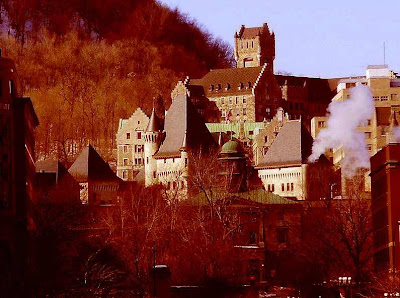




































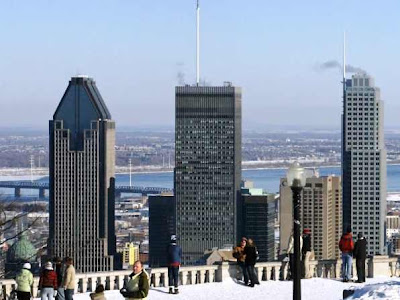








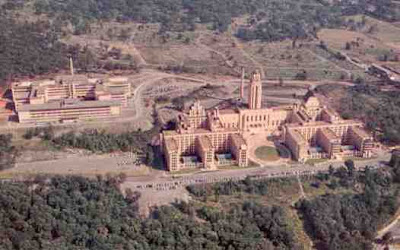








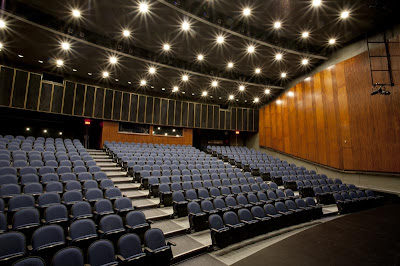
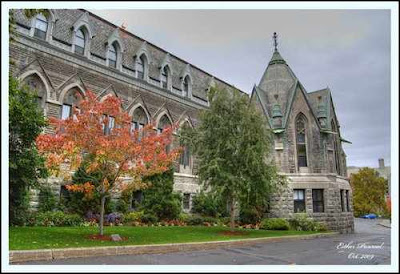








No comments:
Post a Comment